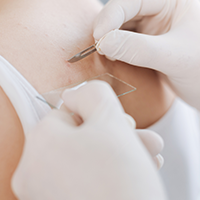

Australasian Journal of Dermatology provides the latest peer-reviewed, original research articles, reviews and case reports dealing with all aspects of clinical practice and research in dermatology.
Featured Article
An individual patient data meta-analysis of wound care in patients with toxic epidermal necrolysis
Lee, J.S. Mallitt, K. Fischer, G. Saunderson, R.B.
Toxic epidermal necrolysis (TEN) involves extensive mucocutaneous loss and care is supportive. The approach to wound care involves surgical debridement or using dressings while leaving the epidermis intact. As scientific evidence for either approach is limited, a systematic review and meta-analysis was undertaken to determine whether surgical debridement compared to dressings while leaving the epidermis in situ will lead to a mortality benefit in adult patients with TEN.
A total of 54 studies involving 227 patients were included in the study, with a GRADE score from very low to moderate. Findings suggest that there was no significant difference in survival in patients who had surgical debridement or dressings. Patients treated with dressings experienced faster re-epithelialization (multivariate HR: 1.96 [1.09–3.51], p = 0.023). Intravenous immunoglobulin (p<0.001) and cyclosporin (p=0.046) significantly reduced mortality, regardless of the wound care method.
This study supports the expert consensus of the dermatology hospitalists that wound care in patients with TEN should be supportive with the epidermis left intact and supported with dressings, leading to faster re-epithelialization.
About the Journal
The Australasian Journal of Dermatology is the official journal of the Australasian College of Dermatologists and the New Zealand Dermatological Society. Editorially independent and peer-reviewed, the journal showcases the latest in dermatology research and innovation.
With four issues a year and special editions, the journal covers clinical presentations, medical and physical therapies and investigations, including dermatopathology, mycology, dermoscopy, surgery and contact dermatitis.
2023 Journal metrics





Accessing the Journal
ACD Members
ACD members have complimentary access to the AJD. Members can access the journal by logging into the Members only section of College’s website and selecting ‘My Online Journals’.
Other Readers
Browse contents, abstracts and subscribe here.
Editorial Board

Associate Professor John Frew
University of New South Wales, Sydney, Australia

Dr Harriet Kennedy
Auckland City Hospital, Auckland, New Zealand
A/Prof Frew is a clinical dermatologist and Director of Research at The Skin Hospital in Sydney, Australia. He is a Conjoint A/Prof of Dermatology at the University of New South Wales and is the current Editor-in-Chief of the Australasian Journal of Dermatology. He currently holds a clinical appointment at Liverpool Hospital in Sydney, Australia and is Head of the Laboratory of Translational Cutaneous Medicine at the Ingham Institute for Applied Medical Research. A/Prof has authored over 130 peer-reviewed articles and has a special interest in pathogenesis and molecular mechanisms of inflammatory dermatoses. | Dr Kennedy is a dermatologist at Auckland City Hospital in New Zealand. She is a general dermatologist with special interests in patch testing and vulval dermatology, and she has a masters degree in contact allergy from the University of Sydney. Dr Kennedy is a honorary Senior Lecturer at the University of Auckland and has been on the Editorial Board of the Australasian Journal of Dermatology since 2018. |
| Dr Nikki Adler | Monash University, Melbourne, Australia |
| Dr Bruno Blaya | The Skin Hospital, Sydney, Australia |
| Dr Peggy Chen | Taranaki District Health Board, New Plymouth, New Zealand |
| Dr Karen Cheung | The Skin Hospital, Sydney, Australia |
| Dr Shih-Sung Cheung | Chi Mei Medical Centre, Tainan, Taiwan |
| Dr Helena Collgros Totosaus | New South Wales Health, Australia |
| Dr Gyohei Egawa | Kyoto University, Kyoto, Japan |
| Dr Haady Fallah | Concord Repatriation General Hospital, Sydney, Australia |
| Prof Pablo Fernandez-Penas | University of Sydney, Sydney, Australia |
| Dr Bryan E.K. Guevara | Southern Philippines Medical Centre, Davao, Philippines |
| Dr Monisha Gupta | The Skin Hospital, Sydney, Australia |
| Dr Izolda Hydenrych | Cosmetic Dermatology Centre, Cape Town, South Africa |
| Prof Johannes Kern | Skin Health Institute, Melbourne, Australia |
| Prof Kiarash Khosrotehrani | Institute for Molecular Bioscience, The University of Queensland Diamantina Institute, Brisbane Australia |
| Dr Joseph Konya | The Skin Hospital, Sydney, Australia |
| A/Prof Christopher McCormack | Peter MacCallum Cancer Centre, Melbourne, Australia |
| Dr Gilberto Moreno Bonilla | The Skin Hospital, Sydney, Australia |
| Dr Je-Ho Mun | Seoul National University, Seoul, South Korea |
| Dr Dany Nassar | Hospital Cochin, Paris, France |
| A/Prof David Orchard | Private Suites Royal Children’s Hospital, Melbourne, Australia |
| Dr Yan Pan | Victorian Melanoma Service, Alfred Hospital, Victoria, Australia |
| Dr Julio Cesar Salas-Alanis | School of Medicine and Health Services TecSalud ITESM, Mexico |
| A/Prof Stephen Shumack | Royal North Shore Hospital of Sydney, Sydney, Australia |
| A/Prof Deshan Sebaratnam | University of New South Wales, Sydney, Australia |
| A/Prof Helmut Schaider | Dermatology Research Centre, The University of Queensland Diamantina Institute, Brisbane, Australia |
| Prof Rodney Sinclair | University of Melbourne and Epworth Hospital, Melbourne, Australia |
| Prof H Peter Soyer | Dermatology Research Centre, The University of Queensland Diamantina Institute, Brisbane, Australia |
| Dr Artiene Tatian | Sydney Children’s Hospital, Sydney, Australia |
| A/Prof Steven Thng | Skin Research Institute of Singapore, Singapore |
| Prof Maurice van Steensel | Institute of Medical Biology, Singapore |
| Dr Etienne Wang | National Skin Centre, Singapore |
| Prof Orli Wargon | Sydney Children’s Hospital, Sydney, Australia |
| Dr Belinda Welsh | Complete Skin Specialists, Sunbury, Victoria, Australia |
| Prof Chao-Chun Yang | National Cheng Kung University, Tainan City, Taiwan |
| Dr Ashfaq Marghoob | Memorial Sloan Kettering Skin Cancer Center, New York, NY, USA |
| Prof John McGrath | St John’s Institute of Dermatology, London, United Kingdom |
| Dr Masaru Tanaka | Tokyo Woman’s Medical University, Medical Center East, Tokyo, Japan |
| Dr Mark Tang | National Skin Centre, Singapore |
| Dr Clark C Otley | Mayo Clinic, Rochester, USA |
